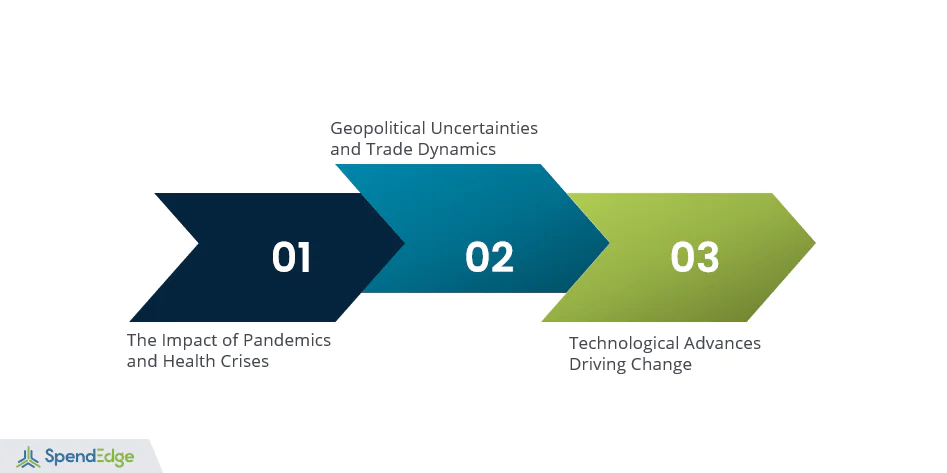The realm of procurement has undergone a seismic shift in recent years, propelled by global events and technological advancements. This essay delves into the challenges and opportunities that characterize this new normal, providing a comprehensive understanding for procurement professionals seeking success in an era defined by volatility and innovation. A thorough exploration of key trends and emerging technologies is necessary to equip organizations with the knowledge and strategies needed to thrive in the face of uncertainty.

The Impact of Pandemics and Health Crises:
I. Disruption of Global Supply Chains:
The pandemic has laid bare the vulnerabilities within global supply chains. Lockdowns, travel restrictions, and factory closures disrupted the production and transportation of goods. Procurement, reliant on streamlined supply chains, faced unprecedented challenges. Companies experienced delays in receiving essential materials, affecting production schedules, and leading to increased lead times. The fragility of just-in-time inventory systems became evident as disruptions echoed through various industries, prompting a reevaluation of supply chain strategies.
II. Shift in Priorities:
The health crisis prompted a swift shift in procurement priorities. Previously, cost efficiency and optimization were at the forefront. However, the pandemic underscored the need for resilience and risk mitigation. Procurement strategies pivoted towards building robust and flexible supply chains that could withstand unforeseen disruptions. Organizations started factoring in risk assessment and diversification of suppliers, moving away from a singular focus on cost reduction.
III. Increased Emphasis on Digitalization:
The pandemic accelerated the adoption of digital technologies in procurement processes. Remote working became the norm, necessitating the digitization of procurement workflows. E-procurement systems, digital collaboration tools, and cloud-based platforms gained prominence. Organizations sought to enhance agility and transparency by leveraging technologies such as artificial intelligence and machine learning for data analysis, forecasting, and risk management.
IV. Supply Chain Transparency and Resilience:
The health crisis highlighted the importance of supply chain transparency. Companies recognized the need to trace and monitor every link in the supply chain to identify vulnerabilities. Blockchain technology gained traction for its ability to provide an immutable and transparent record of transactions. This not only enhanced visibility but also contributed to building resilient supply chains capable of withstanding disruptions.
V. Dynamic Vendor Relationships:
The pandemic necessitated a reevaluation of vendor relationships. Procurement professionals started prioritizing collaboration and communication with suppliers to ensure a mutual understanding of challenges and solutions. Dynamic relationships became crucial, with an emphasis on strategic partnerships rather than mere transactional interactions. This shift allowed for a more agile response to disruptions, as organizations and suppliers worked together to find innovative solutions.
VI. Demand for Ethical and Sustainable Procurement:
The pandemic increased awareness of social and environmental issues, prompting a demand for ethical and sustainable procurement practices. Companies and consumers alike began to prioritize suppliers with transparent and responsible practices. Procurement professionals responded by integrating ethical considerations into supplier selection, contributing to a more sustainable and socially responsible business environment.
VII. Agility and Contingency Planning:
Procurement strategies evolved towards greater agility and contingency planning. The ability to adapt swiftly to changing circumstances became a competitive advantage. Organizations developed robust contingency plans, including alternative sourcing strategies, to mitigate the impact of unforeseen disruptions. Procurement professionals embraced agility as a core competency, enabling them to navigate the uncertainties of the new normal effectively.
Geopolitical Uncertainties and Trade Dynamics:
I. Shifting Trade Dynamics:
Geopolitical uncertainties have cast a profound impact on trade dynamics, significantly influencing procurement strategies. Trade tensions between major economies have created an environment of unpredictability, prompting organizations to reassess and recalibrate their procurement approaches. Tariffs, trade barriers, and geopolitical disputes have disrupted established supply chains, leading to increased complexity and risk in global procurement.
II. Impact on Supplier Relationships:
Geopolitical uncertainties directly affect supplier relationships, compelling organizations to evaluate the geopolitical risks associated with their suppliers. Dependence on suppliers from geopolitically sensitive regions can expose companies to sudden disruptions. Procurement professionals are now tasked with not only ensuring the quality and cost-effectiveness of supplies but also managing geopolitical risks associated with specific suppliers or regions.
III. Diversification Strategies:
In response to geopolitical uncertainties, organizations are actively pursuing diversification strategies to reduce dependence on a single source or region. Procurement teams are identifying alternative suppliers and establishing diverse supply chains to mitigate the risks associated with geopolitical tensions. This diversification not only enhances resilience but also provides organizations with greater negotiating power in an unpredictable geopolitical landscape.
IV. Trade Policy Changes and Compliance Challenges:
Shifting trade dynamics often lead to changes in trade policies and regulations. Procurement professionals must stay vigilant and adapt to evolving regulatory environments, ensuring compliance with new trade agreements and tariffs. Frequent changes in trade policies can introduce complexities in procurement processes, requiring continuous monitoring and adjustment to maintain regulatory compliance.
V. Currency Fluctuations and Financial Risks:
Geopolitical uncertainties contribute to currency fluctuations, exposing organizations to financial risks in international procurement. Volatility in exchange rates can impact on the cost of imported goods and services, affecting budgetary considerations. Procurement teams must implement effective risk management strategies, such as currency hedging, to mitigate the financial impact of geopolitical uncertainties on procurement budgets.
VI. Strategic Sourcing and Resilience:
Geopolitical uncertainties have elevated the importance of strategic sourcing as a key component of procurement resilience. Strategic sourcing involves not only selecting suppliers based on cost and quality but also considering geopolitical factors. Procurement professionals must analyze the geopolitical landscape to identify potential risks and opportunities, informing strategic sourcing decisions that align with the organization’s overall risk tolerance and resilience objectives.
VII. Technology as a Mitigating Factor:
Advancements in technology play a crucial role in helping organizations navigate the challenges posed by geopolitical uncertainties. Procurement technologies, including predictive analytics and supply chain visibility tools, enable organizations to anticipate and proactively address potential disruptions. By leveraging technology, procurement professionals can enhance their ability to make informed decisions in the face of geopolitical uncertainties.
VIII. Collaborative Risk Management:
Geopolitical uncertainties necessitate a collaborative approach to risk management. Procurement professionals are increasingly engaging with cross-functional teams, including legal, finance, and risk management, to collectively address and mitigate geopolitical risks. Collaborative risk management ensures a holistic understanding of the potential impacts on procurement and enables organizations to develop comprehensive risk mitigation strategies.
Technological Advances Driving Change:
Artificial Intelligence and Machine Learning in Procurement:
I. Enhanced Data Analysis and Decision-Making:
Artificial Intelligence (AI) and Machine Learning (ML) have revolutionized procurement by offering advanced data analysis capabilities. These technologies enable the processing of vast datasets at unprecedented speeds, extracting valuable insights for procurement professionals. Through predictive analytics, AI and ML algorithms forecast demand, identify market trends, and optimize inventory levels. This enhanced data analysis empowers procurement teams to make informed decisions based on real-time and historical data, leading to more strategic and efficient procurement processes.
II. Supplier Risk Assessment and Management:
One significant application of AI and ML in procurement is the assessment and management of supplier risks. These technologies can analyze diverse data sources, including financial reports, news articles, and social media, to evaluate the stability and reliability of suppliers. By identifying potential risks early on, procurement professionals can proactively implement mitigation strategies, ensuring the resilience of the supply chain. This predictive approach minimizes the impact of unforeseen disruptions, contributing to overall procurement stability.
III. Automation of Routine Tasks:
AI and ML technologies automate routine and repetitive tasks in procurement, streamlining operational processes. This includes tasks such as data entry, invoice processing, and purchase order management. Automation not only increases efficiency but also reduces the likelihood of errors, allowing procurement professionals to focus on more strategic activities. The time saved through automation enables teams to engage in complex decision-making, negotiations, and relationship-building with suppliers.
IV. Dynamic Supplier Performance Monitoring:
Traditional supplier performance monitoring often involves periodic assessments. AI and ML introduce dynamic and continuous monitoring capabilities. These technologies analyze real-time data to evaluate supplier performance against predefined key performance indicators (KPIs). Dynamic monitoring allows procurement teams to swiftly identify deviations from expected performance and take immediate corrective actions, fostering a more agile and responsive supply chain.
V. Cost Optimization Through Smart Negotiation:
AI and ML play a pivotal role in optimizing costs through intelligent negotiation processes. These technologies analyze historical data, market trends, and supplier behavior to recommend optimal negotiation strategies. By leveraging AI-driven insights, procurement professionals can enhance their negotiation skills, securing better terms, prices, and contractual agreements. This contributes to overall cost optimization and strengthens the organization’s negotiating position in the procurement landscape.
The integration of AI and ML in procurement signifies a transformative leap towards efficiency, risk mitigation, and strategic decision-making. As these technologies continue to evolve, their impact on procurement processes is likely to deepen, ushering in an era of unprecedented precision and adaptability in the management of supply chains and vendor relationships.
Blockchain and Smart Contracts:
Blockchain technology and smart contracts are reshaping the landscape of procurement, introducing unprecedented levels of transparency, security, and efficiency. Blockchain, as a decentralized and immutable ledger, enhances the visibility of transactions across the supply chain. It ensures a temper-resistant record of every interaction, from sourcing to delivery, fostering trust among stakeholders. Smart contracts, self-executing contracts with coded terms and conditions, automate and enforce procurement agreements. These contracts operate on the blockchain, triggering predefined actions when specific conditions are met. This automation streamlines processes such as payment verification, order fulfillment, and compliance monitoring, reducing the need for intermediaries and minimizing the risk of errors or disputes. Together, blockchain and smart contracts create a more transparent, secure, and streamlined procurement ecosystem, fostering trust among parties and paving the way for increased efficiency and reliability in supply chain management.
In conclusion, navigating procurement in the new normal requires a holistic and strategic approach that encompasses technological adoption, agile practices, and a commitment to sustainability. By understanding the challenges posed by global events and technological shifts, organizations can position themselves to thrive in an environment characterized by uncertainty and rapid change. Leadership plays a pivotal role in driving procurement excellence, emphasizing the need for a culture of innovation and continuous learning. Through case studies, we have seen how organizations have successfully embraced these strategies, providing valuable insights for others seeking to navigate the complexities of procurement in the new normal. As we forge ahead, the ability to adapt and innovate will be the cornerstone of procurement success in the ever-evolving business landscape.




